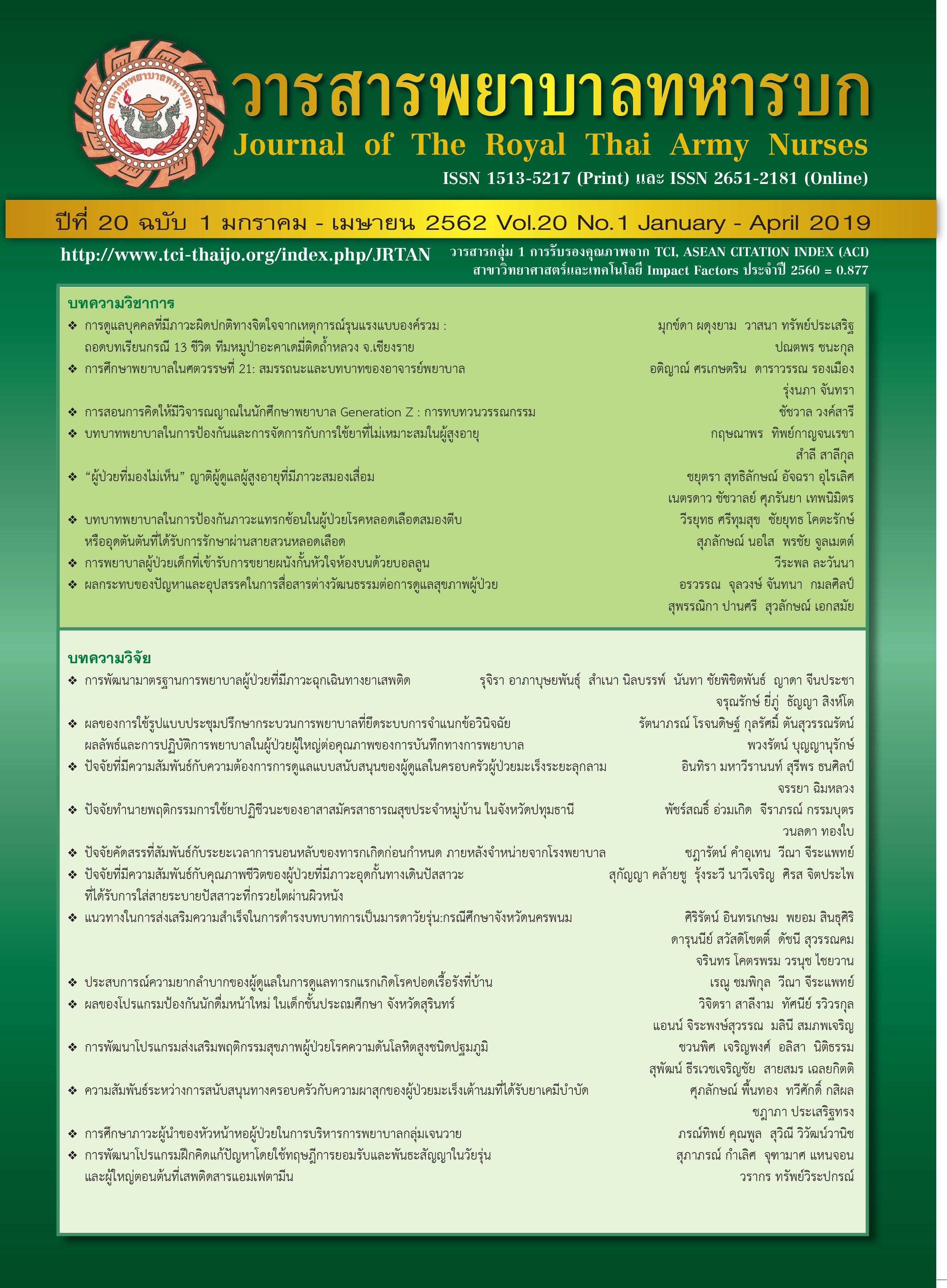Therapeutic Footwear Wearing Behaviors among Persons with Diabetes
Keywords:
Therapeutic Footwear Wearing Behaviors, Diabetic FootAbstract
This descriptive research was aimed to explore therapeutic footwear wearing behaviors among persons with diabetes who received therapeutic footwear and their health belief perceptions. The sample group composed of 80 Diabetes persons who had their routine followed up visit and received therapeutic footwear at chronic cound clinic of the surgical outpatient unit of Ramathibodi Hospital. Data were analyzed using descriptive statistics, content analysis, and Spearman rank correlation coefficient. Research results and additional analysis showed that most persons with diabetes had medium to high therapeutic footwear wearing behaviors. Perceptions on risk of Diabetic foot ulcer, severity of diabetic foot ulcer, benefits of therapeutic footwear wearing were at high levels and significantly positively related to wearing therapeutic footwear behaviors (r = 0.272 p < .05, r = 0.239 p < .05, r = 0.564 p < .01, respectively), whereas perception of the obstacles for wearing therapeutic footwear was at a low level and was significantly negatively related to therapeutic footwear wearing behaviors, (r = -0.519, p < .01). These research finding can be utilized in nursing plans, especially in patients with high risk for Diabetic foot ulcer for appropriate therapeutic footwear wearing behaviors to reduce incidence of diabetic foot ulcers and amputations.
Downloads
References
Arts MLJ, Haart M, Bus Sam, Bakker JPJ, Hacking HGA, Nollet F. Perceived usability and use of custom made footwear in diabetic patients at high risk for foot ulceration. Journal of Rehabilitation Medicine. 2014; 46(4): 357-68.
Bus SA, Waaijman R, Arts M, Haart M, Busch WT. Effect of custom-made footwear on foot ulcer recurrence in Diabetes: A multicenter randomized controlled trial. Diabetes care. 2013; 12(6): 4109 – 16.
Jarl G, Lundqvist LO. Adherence to wearing therapeutic shoes among people with diabetes: a systematic review and reflections. Patient Preference and Adherence. 2016; 10(1): 1521–28.
Macfarlane DJ, Jensen JL. Factors in diabetic footwear compliance. Journal of the American Podiatric Medical Association. 2003; 93(6): 485-91.
Waaijman R, Keukenkamp R, Haart M, Polomski WP, Nollet F, Bus SA. Adherence to wearing prescription custom made footwear in patients with diabetes at high risk for plantar foot ulceration. Diabetes Care. 2013; 36(6): 1613-18.
Siriniyomchai R. Therapeutic footwear: Nurses’ roles. Ramathibodi Nursing Journal. 2015; 21(3): 298 – 308. (in Thai)
Sangkum W, Chuithong P, Tunsakul S. Factors related to foot complications prevention behaviors among patients with Diabetic Mellitus type 2. Graduated research, Mahidol University; 2012. (in Thai)
Becker MH. The health belief model: A decade later. Health education Quarterly. 1984: 1 – 47.
Phumwisaid J. Health Belief and Health Behaviors among Diabetes Mellitus Type 2 Patients, Phato Hospital, Chumphon Province. Medical Journal Region 11. 2014; 28(1): 89 – 100. (in Thai)
Tan MY. The relationship of health beliefs and complication prevention behaviors of Chinese individuals with Type 2 Diabetes Mellitus. Diabetes Research and Clinical Practice. 2004; 66(1): 71 – 77.
Klinchet N, Wattanakijkrailert D, Jareonkijkan W, Wongsurakean P. Influences of Creatinine Clearance, Cough Effectiveness, Perceived Sleep Quality, Perceived Severity of Illness on Duration of Spontaneous Breathing Trail in Patients with Simple Ventilator Weaning. Journal of The Royal Thai Army Nurses. 2015; 16(3): 105 – 110. (in Thai)
Lavery LA, LaFontaine J, Higgins KR, Lanctot DR & Constantinides G. Shear-reducing insoles to prevent foot ulceration in high-risk diabetic patients. Advances in Skin & Wound care. 2012; 25(11): 519-24.
Tiparat W, Saraluk P, Lertwanawattana J, Pratum S. The effect of the self efficacy and social support program enhancing to low salt dietary behavior and the level of blood pressure in elderly patients with hypertension. Thai Journal of Cardio – Thoracic Nursing. 2014; 25(1): 72 – 84. (in Thai)
Downloads
Published
How to Cite
Issue
Section
License
บทความหรือข้อคิดเห็นใดใดที่ปรากฏในวารสารพยาบาลทหารบกเป็นวรรณกรรมของผู้เขียน ซึ่งบรรณาธิการหรือสมาคมพยาบาลทหารบก ไม่จำเป็นต้องเห็นด้วย
บทความที่ได้รับการตีพิมพ์เป็นลิขสิทธิ์ของวารสารพยาบาลทหารบก
The ideas and opinions expressed in the Journal of The Royal Thai Army Nurses are those of the authors and not necessarily those
of the editor or Royal Thai Army Nurses Association.






